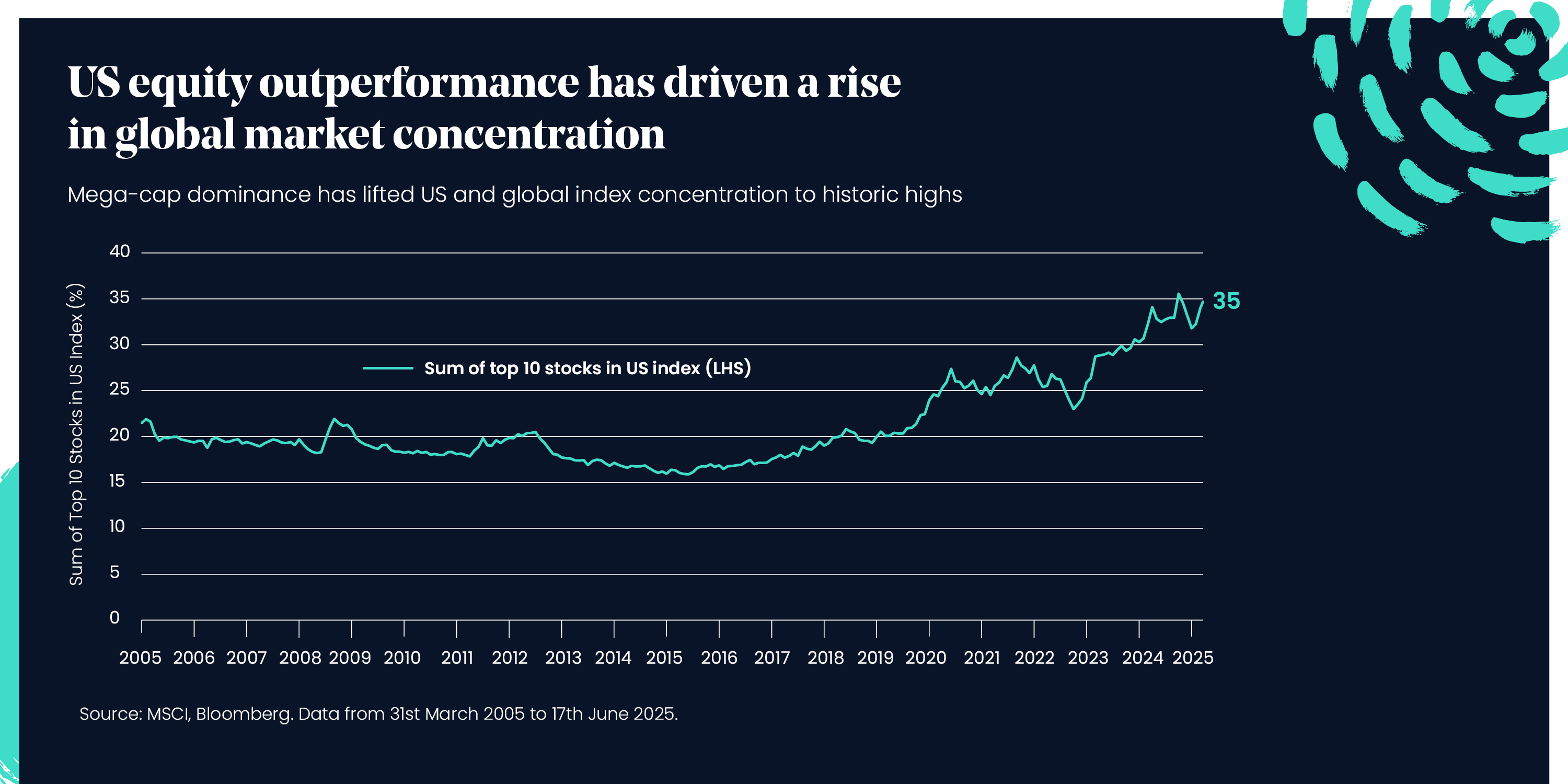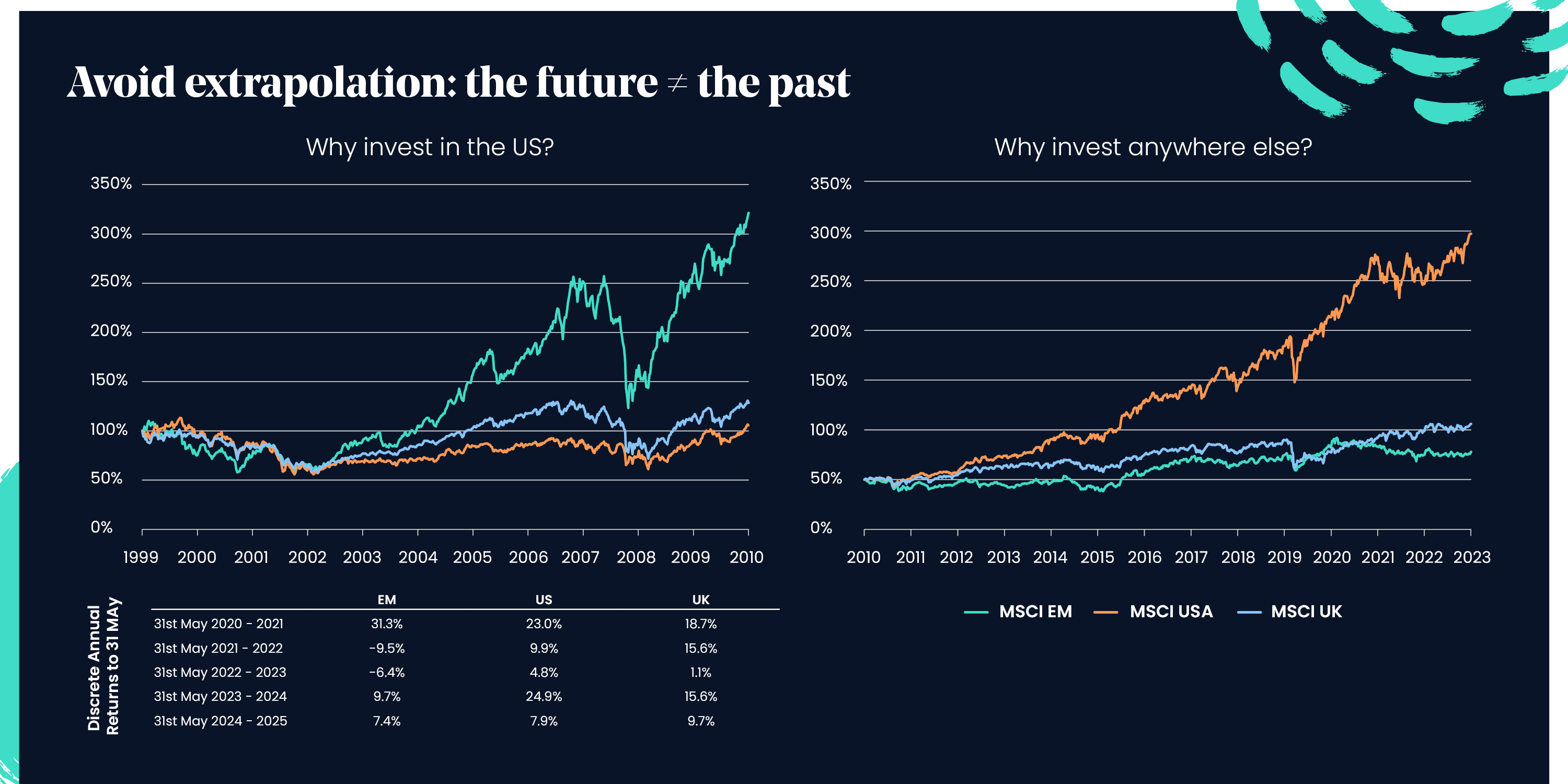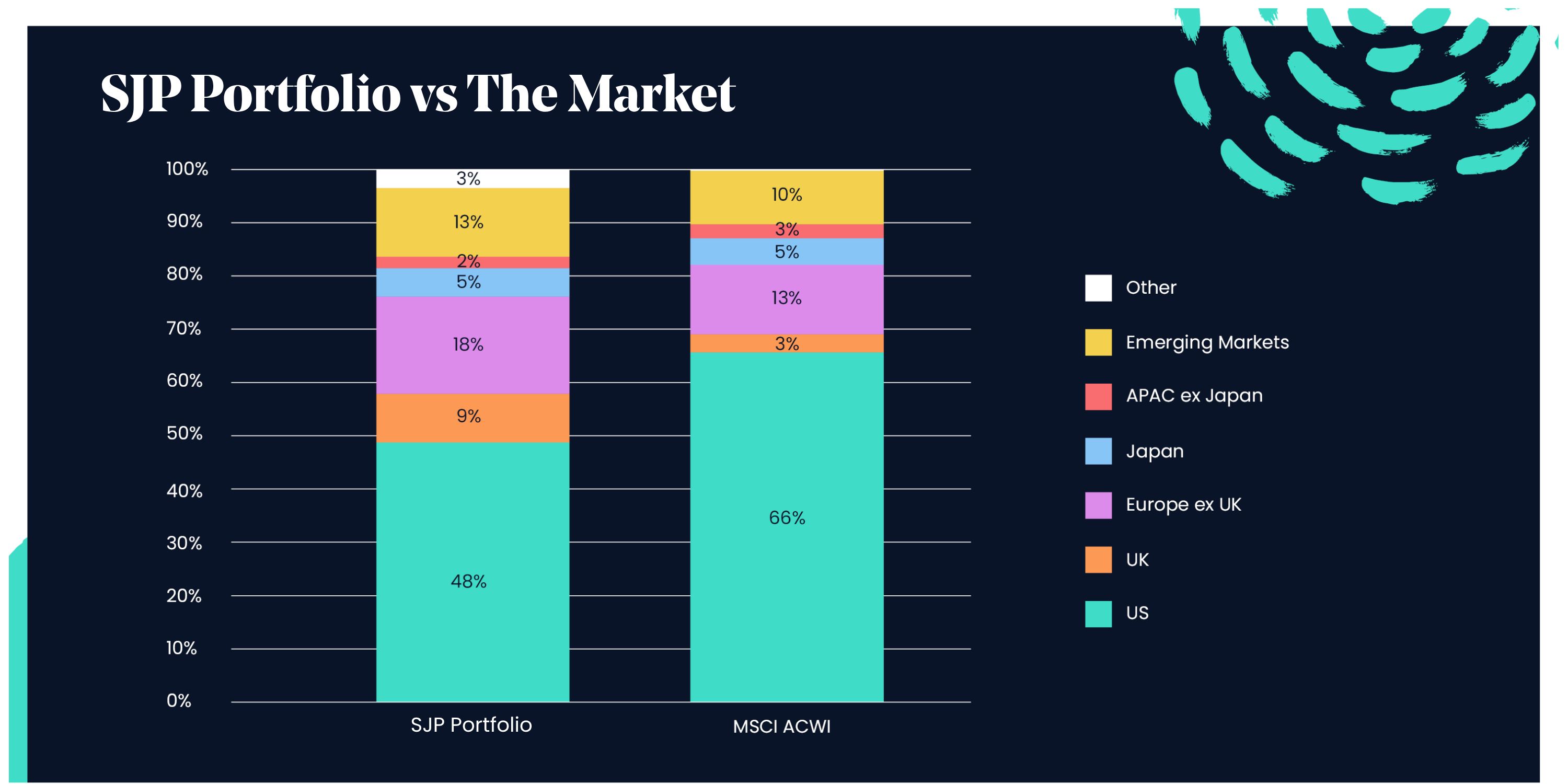- News
- Investing
What is happening with US politics? What will the volatility mean for my investments and US holdings? In the numerous client events I hosted in recent months, from Dubai to Singapore and back to Hong Kong, these have been the questions on almost every investor’s lips.

At a glance
- US politics are causing significant market volatility, leaving investors uncertain. It is times like these that are most important to focus on your goals and keep your portfolios resilient.
- The concentration conundrum increases US equity risk, and we favour other, more attractive positions in making our portfolios resilient.
- That said, we still invest significantly in the world’s largest market – the key is striking a balance.
And it’s not surprising. Or unexpected. The geopolitical picture appears to change daily, much of it driven by announcements or Truth Social posts made by President Trump, many of which he later retracts or reverses. Markets have moved up and down as announcements are made, followed by concessions. The breakout of the recent Iran conflict saw markets move less, but they still reacted. This can all be unnerving for investors, to say the least.
I have recently found myself discussing market turbulence and the importance of portfolio resilience. As markets fluctuate, the noise surrounding volatility can be deafening. But it is the wrong thing to focus on.
Earlier this year, I also looked at how, in uncertain environments, ‘fat tails’ – a term for extreme outcomes – become more likely. To put it another way, events can suddenly take a sharp turn and destabilise even experienced investors. Unfortunately, this is what we are currently witnessing in many areas.
Red caps: Rising uncertainty and politics
Trump is nothing if not a populist. And behind many of his decisions lies the sentiment, ‘Make America Great Again.’ These are the words you see on many red baseball caps at Trump rallies and in media coverage, and which resonate with millions of US voters.
Take the tariffs, which have swung from one direction to another and back again. The aim of these is ostensibly to reduce any trade deficits between the US and other countries. The thinking is that US companies have been at a disadvantage compared to their counterparts in other parts of the world because of the tariffs they face when exporting goods and services. By imposing tariffs on foreign-produced imports to the US, it will make US-produced goods more attractive to US consumers, so the argument goes.
Yet while tariffs may temporarily reduce trade deficits, they also cause potential economic harm. While we don’t have unfettered confidence in anyone’s ability to make economic forecasts, the International Monetary Fund has estimated that Trump’s tariffs could reduce global economic growth by 0.5% next year1. Meanwhile, in the short term, the tariffs could also increase costs for US consumers, potentially leading to higher inflation.
With Trump’s 90-day pause on reciprocal tariffs due to end imminently (July 9th), more volatility may lie ahead. While some countries, such as the UK, have secured some deals, it remains to be seen whether Europe will reach a beneficial trade deal with the US. All is still to play for where China is concerned, too.
Meanwhile, tensions remain high in the Middle East, despite a fragile ceasefire between Israel and Iran (at the time of writing). The Russian president has also taken advantage of the geopolitical focus being elsewhere to intensify attacks on Ukraine, with that war still very much ongoing. With conflicts impacting supply chains and driving up the price of oil, our investment experts recently produced a valuable document worth reading – “Five things to consider amid market uncertainty”. It highlights our geopolitical checklist – things we consider market-moving events, such as those we are seeing this year.
Despite this gloomy backdrop, the latest US consumer sentiment figures show people are feeling slightly more positive about the economy. According to the University of Michigan’s consumer sentiment index published in June, Americans’ view of the economy has improved for the first time in six months2.
US policy, in particular, is still raising questions and uncertainty for investors, as I see all too clearly when meeting with clients. What’s next? That’s the hard part. What will lead the markets up—or down—mid such unpredictability? And where does that leave us as investors?
The US equity concentration conundrum
The US concentration conundrum is glaring: around two-thirds of global equities now sit in the US. This is up significantly over the last decade or so.
Yet it doesn’t stop there. Over the past decade, US equities have substantially outperformed their international counterparts. These returns have been driven by a handful of extraordinarily large US companies, particularly the so-called “Magnificent 7” stocks (Apple, Amazon, Alphabet, Meta, Nvidia, and Tesla). The top 10 stocks in the US make up over a third of the market, marking the highest concentration in six decades.

The technology concentration in the index is also now approaching the “dot com” boom levels of the late 1990s, despite the reclassification of several names in the index (e.g., companies such as Amazon being moved from Technology to Consumer Discretionary).
Given this concentration, I would highlight the importance of managing overall risk. If an investor’s appetite for risk has not changed, it is hard to argue that they should hold more of a concentrated market at higher valuations. For a medium-term investor, on the balance of probabilities, the outlook for US equities versus the rest of the world appears challenged.
It can be hard when examining the data to think that the dominance of the US market will not continue. And yet, if history shows us anything, it’s that past performance is no prediction of future outcomes. This is borne out time and again.
As the charts below illustrate, in the first decade of the 21st century, emerging markets were the standout growth story. US equities were largely flat over the same period. However, between 2010 and 2023, the US equities far outperformed emerging markets and also UK equities. And who knows what will happen in the coming years, particularly given the extremely volatile geopolitical environment and the economic pressures the US is facing.

Our position
For the above reasons, and given that we see more attractive opportunities from Europe to Japan and Asia/Emerging Markets, we are leaning away from the US. Having said that, we still invest significantly in the world’s largest market. Indeed, it remains the largest equity position we have across our portfolios. The US makes up a significant portion of the world market, so the risk of not having substantial exposure outweighs the risks we think it poses to future returns. We need to strike a balance. As such, we allocate less to the region versus its share in global markets. Heading into the third quarter, our asset allocation stance indicates that we are significantly underweight in the country (~15% below market weight for one of our core portfolio offerings).

To conclude
Data shows that being out of the US market in recent years could be costly for investors. Yet, it is about taking a considered approach and thinking long term. It is worth pointing out that, despite the noise, the connection between politics and equity markets is actually quite vague. Politics may temporarily move the markets, but over the medium to long term, it’s a different story.
What really matters is valuations over the median term. You can’t just use valuations blindly—something may have a high value, but that doesn’t necessarily make it a good investment. We believe as investors you have to think of moderators. These are the fundamentals, sentiment, tail risks and economics. That’s why valuations are at the heart of our process and will continue to be, regardless of the volatility in the economic climate. Or US politics.
This article is a general communication that is provided for informational purposes only. It should not be relied upon as financial advice, and it does not constitute a recommendation, an offer or solicitation. No responsibility can be accepted for any loss arising from action taken or refrained from based on this publication. All information presented herein is considered to be accurate at the time of production, but no warranty of accuracy is given and no liability in respect of any error or omission is accepted.
This advertisement has not been reviewed by the Monetary Authority of Singapore.
MSCI makes no express or implied warranties or representations and shall have no liability whatsoever with respect to any MSCI data contained herein. The MSCI data may not be further redistributed or used as a basis for other indices or any securities or financial products. This report is not approved, endorsed, reviewed or produced by MSCI. None of the MSCI data is intended to constitute investment advice or a recommendation to make (or refrain from making) any kind of investment decision and may not be relied on as such.
Please note that past performance is not an indicative of future performance, and the value of an investment with St. James’s Place will be directly linked to the performance of the funds selected and may fall as well as rise. You may get back less than the amount invested.
The value of an investment in equities and shares may go up and down. You may get back less than the amount invested. This is different to the capital security typically associated with bank deposits held in cash.
Source
1International Monetary Fund, The Global Economy Enters a New Era, April 2025
2TradingEconomics, United States Michigan Consumer Sentiment, June 2025
Most recent articles



